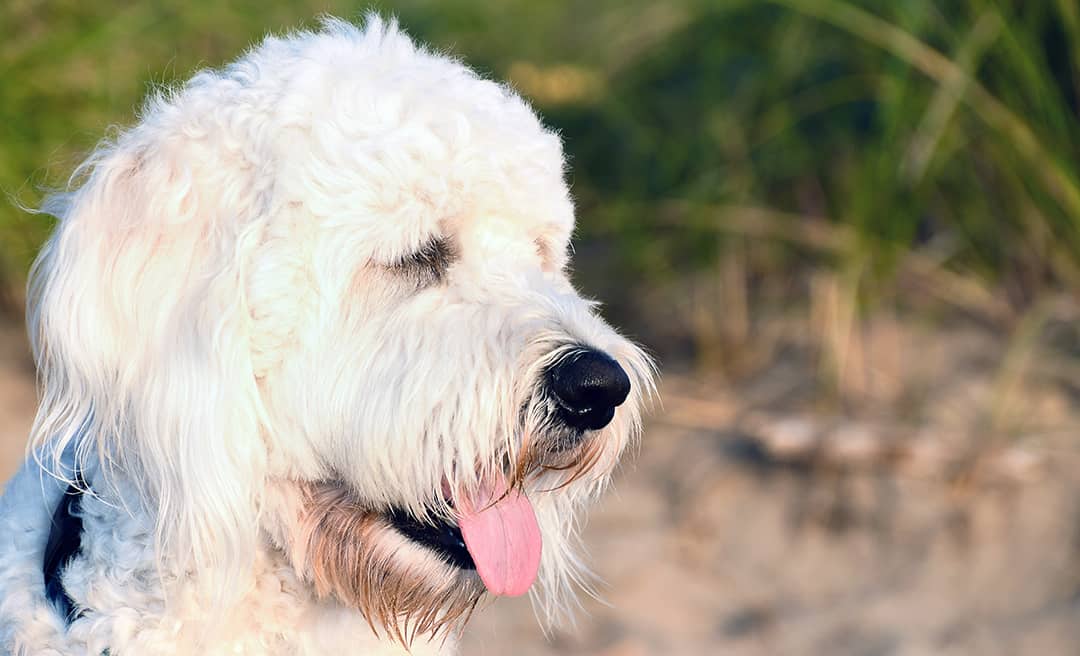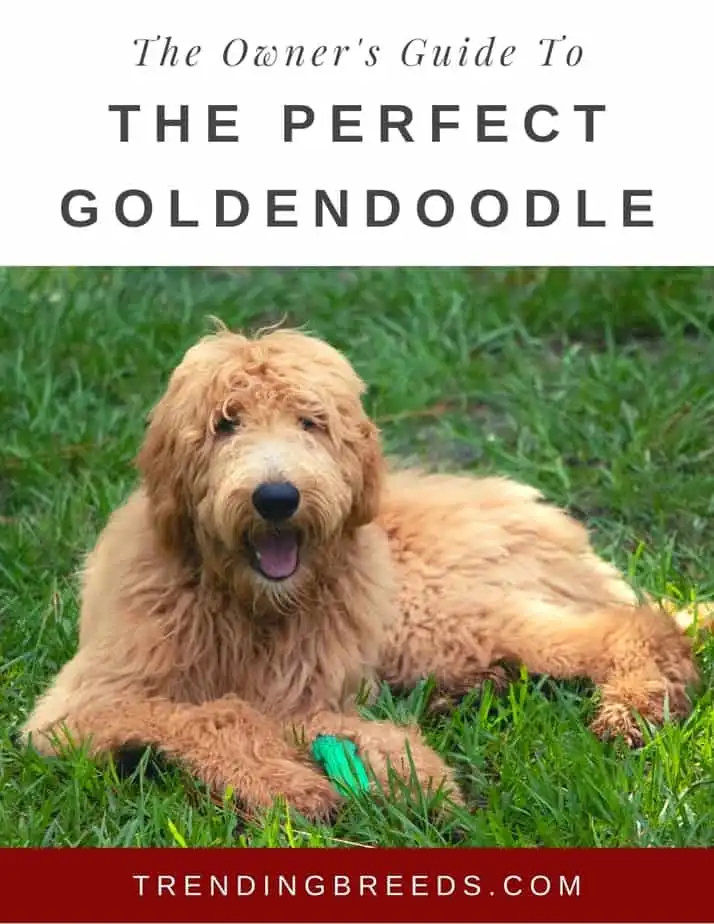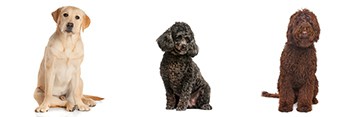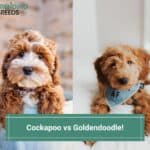The Goldendoodle was created by crossing a Golden Retriever and a Poodle with the hope of producing a crossbreed that displayed the sweet temperament of a Golden Retriever and the high intelligence and low shedding of a Poodle. Well, it worked!
This relatively new designer dog is steadily gaining popularity as more people become familiar with Goldendoodles and their incredible personalities.
They are not only smart, friendly, loyal, and affectionate but also are typically well tolerated by allergy sufferers.
What Is A Multi-Generational Goldendoodle?
What is a multi-generational Goldendoodle? A multi-generational (multigen) Goldendoodle is the product of breeding two Goldendoodles beyond the second generations (F2). Meaning both the dog’s parents and grandparents are Goldendoodles, not purebred Poodle or Golden Retriever. Most breeders consider F3 generations and beyond to be multigen. Various breeding combinations can be used to increase the likelihood of desired traits such as low shedding, coat type, and allergen levels.
A variety of factors work together to produce quality multi-generational Goldendoodles.
The genetics behind the generations can be confusing, so let’s keep it simple as we take a closer look at the different generations, specifically the multi-generational Goldendoodle, and see which generation is best for you!
Understanding Goldendoodle Generations
The genetics behind crossbred dogs like the Goldendoodle can be admittedly tricky to understand.
Without a set standard in place as with purebred, officially recognized breeds, breeders have the freedom to use terms according to their own definition.
The terms used to describe the various generations of Goldendoodles are, however, a bit more universal.
Before we dive in here, let me say one thing. We highly recommend picking up a Goldendoodle-specific guidebook if you’re seriously considering this breed.
Why? Well, for example, with a Basset Hound, you pretty much know what to expect. You’re not going to be enjoying fast-paced runs every morning with your dog, right?
Goldendoodles, however, are the product of melding two breeds into one, so there are a lot of variations and unexpected results that can occur.
Our well-researched book, The Owner’s Guide to the Perfect Goldendoodle will give you deep insight into why your dog is the way that he is, which will translate into a better relationship and experience with your dog.
This book explains everything from purchasing to generations to shedding tendencies to training to grooming – everything you need to know in order to raise the dog of your dreams.
You’ll also find information on feeding, dealing with common issues, possible health conditions to watch for, recommended supplies and tools, and so much more.
It doesn’t get any better than that! Grab your copy today – it will be the book you turn to again and again.
That said, let’s go over the terms that are most commonly used when speaking of Goldendoodle generations.
This 75+ page book is jam-packed with expert knowledge and real experiences from Goldendoodle owners and breeders alike. Consider this the ultimate owner’s guide for the breed with tips, tricks, and answers to the most frequently asked questions – saving you time, money, and loads of frustration along the way.
Where It All Starts
To produce Goldendoodles, a Golden Retriever is bred to a Poodle, and the resulting litter of puppies is referred to as the first generation or F1 for short.
F1 puppies usually have that adorable “teddy bear” look and a long, wavy coat. F1s’ shedding tendencies are hard to predict because the puppies may take after either parent breed.
If an F1 generation dog is bred back to a Poodle, the puppies are called F1b, with the “b” standing for back-cross.
Adding more Poodle genes to the mix produces puppies who are 25% Golden Retriever and 75% Poodle.
F1b dogs usually have curlier coats that tend to shed very little and are generally well tolerated by those who suffer from allergies.
Some breeders choose to breed an F1b back to a Poodle to create what they refer to as an F1bb. These dogs tend to shed very little thanks to the addition of more Poodle to the bloodline.
When two F1 Goldendoodles are bred, the puppies are called second generation – F2.
This generation produces puppies that are similar to F1 dogs in that they are also half Golden Retriever and half Poodle, and shedding qualities can vary within the litter.
[mv_video doNotAutoplayNorOptimizePlacement=”false” doNotOptimizePlacement=”false” jsonLd=”true” key=”cdgvg6gcvnzwvhb5a8rs” ratio=”16:9″ thumbnail=”https://mediavine-res.cloudinary.com/v1607182037/rd5xk1axqq41dprzlips.jpg” title=”Meet 6 Adorable Goldendoodles” volume=”70″]
Here’s where it gets interesting…
Goldendoodles referred to as F2b can be produced in several ways, with each breeder having their own preferences.
An F2 or F1b can be back-crossed to a Poodle, or an F1 can be bred with an F1b.
F2b Goldendoodles usually have only minimal shedding and are a good choice for allergy sufferers due to the higher concentration of Poodle genes.
Third generation Goldendoodles are known as F3. This generation, like F2b, can also be produced by a number of combinations.
Typical methods include breeding an F1B to an F1B, an F1B to an F2B, an F2 to an F2, two F2Bs, or two F3s.
The term multi-generational (or multigen) typically is used when speaking of F3 generation puppies and beyond, though some breeders refer to any generation after F1 as multi-generational.
Multigens have a good deal of genetic diversity, so puppy characteristics can vary greatly. So, be sure to check with breeders for clarification on what they consider to be multigen.
Do They All Need Grooming?
Regardless of which generation you choose, you’re going to need a couple of essential grooming tools to keep the coat healthy and looking its best.
Here’s what we recommend for all Doodle dogs:
- Sturdy slicker brush – This brush is essential for everyday coat care as it removes loose hair and dander, distributes natural oils, and works through tangles. Best of all, it releases trapped hair with the push of a button.
- Stainless steel dematting comb – This is another essential for Doodle dogs. It easily works through the inevitable mats without pulling out huge chunks of surrounding fur and causing unnecessary damage to the coat.
- Stainless steel comb – To help prevent matting in any Poodle mix dog, this comb is truly a must-have. One half features closely spaced thin tines for detail work and the other half has tines spaced farther apart for general combing. A versatile, gentle comb!
Also, be sure to check with our Complete Goldendoodle Grooming Guide for other recommended supplies and a step-by-step lesson on properly grooming a Doodle.
What Makes Multi-Generational Goldendoodles Better?
Many multi-generational Goldendoodles have a higher prevalence of Golden Retriever in their bloodline and can, therefore, more closely resemble a Retriever than a Poodle in terms of temperament.
This is an advantage for people who are more concerned with personality than with appearance.
You see, Poodles tend to be rather high strung and excitable, while Golden Retrievers are famous for their laid-back yet eager-to-please dispositions.
So people searching for an easy-going, relaxed Goldendoodle generation usually gravitate toward a multigen.
Often, breeders report that their multi-generational Goldendoodles are quite low shedding and are allergy friendly.
This can indeed be the case if DNA testing is performed prior to breeding to determine how the parent dogs’ genes for shedding and coat will combine within a litter.
One drawback of multi-generational Goldendoodles is the fact that the further the generation is from the original purebred breeds, the less “hybrid vigor” advantage is seen.
Hybrid vigor refers to the overall good health enjoyed by crossbred dogs.
For example, certain forms of cancer that often show up in Golden Retrievers are not typically seen in multi-generational Goldendoodles.
In case you’re wondering about what health issues do tend to pop up in Goldendoodles, rest assured that they are generally healthy dogs.
However, hybrid vigor does not mean that the dog will never experience any health concerns at all.
In this article, we go over a few conditions that are sometimes seen within this breed.
A word of warning: Always ask to see the puppy’s pedigree before purchasing.
Some low-quality breeders resort to intense inbreeding in order to produce multiple generations without having to keep different bloodlines and many dogs on their premises.
You’ll find our list of well-respected Goldendoodle breeders to be helpful when searching for a breeder close to your area.
Multigen Coat Types
Because of the genetics at play in multigens, all three coat types are possible, each with its own unique set of qualities.
Wavy Coat
The soft, wavy coat can occur in all generations of Goldendoodles and is fairly common in multigens.
Also called a teddy bear coat, the wavy coat has an irresistible shaggy appearance, hair-like texture, and is usually low shedding.
Regular brushing is required to keep this coat tangle-free.
Curly Coat
The curly coat is also fairly common and can consist of loose curls, tight curls, or curls somewhere in between.
Considered to be the lowest shedding coat, this coat can look similar to a Poodle’s, but because it can easily develop mats, daily brushing is required.
Many owners choose to clip the coat to make grooming more manageable.
Straight Coat
The smooth straight coat resembles that of a Golden Retriever but is quite fluffy. This is the easiest coat type to care for as it only requires minimal brushing.
Goldendoodles with a straight coat usually shed more than those with a wavy or curly coat and are therefore not as allergy friendly.
Beware of this Coat Type
Though no longer very common thanks to DNA testing, there is one other coat possibility with multigens – the improper, or flat, coat.
Dogs with this coat type closely resemble a Golden Retriever, will shed rather heavily, and lack the long facial hair on the mustache, eyebrows, and beard.
This undesirable coat can largely be avoided through testing for the IC gene in breeder dogs.
What Is the Best Generation of Goldendoodle?
The answer to this question depends on what you are looking for.
- Are you concerned with allergies and shedding? Consider an F1b or F2b.
- Want the healthiest cross with the most hybrid vigor? You’ll want to look at an F1.
- Want a low-maintenance coat? An F2 or F2b is your best bet.
- Looking for a Goldendoodle with a Retriever-like temperament? Consider a multigen (F3 and beyond).
- Want more of the feist you find in Poodles? An F1b or F2b will probably be best.
As you can probably tell now, with Goldendoodles, there really is something for everyone!
What we’ve outlined for you above is a good rule of thumb. You’ll want to confirm with the breeder as there can be some variation from breeder to breeder.
So, Are Multigens Truly Better?
Well, multigen owners certainly think so.
The higher concentration of Golden Retriever genes usually produces Goldendoodles with extremely good temperaments.
The qualities that have made the Golden Retriever so incredibly popular really come through in these multigens.
The truth is that, yes, multi-generational Goldendoodles are wonderful pets with terrific personalities, but you really can’t go wrong with any generation unless you suffer from extremely severe allergies.
All Goldendoodles tend to be quite friendly, highly affectionate, intelligent, and playful – the perfect addition to the family.
This is really just the tip of the iceberg here. There is so much more to love about Goldendoodles! Don’t miss out on the all the other Goldendoodle topics we cover. You can find them all right here.
Related Questions:
Do Goldendoodles need to be groomed?
Yes. To prevent tangles and mats from forming in the coat and to remove loose hairs, Goldendoodles should be brushed daily.
Pay extra attention to areas of high friction, such as beneath the collar. Ear cleaning, toenail clipping, haircuts, and an occasional bath are important as well.
Be sure to check with our grooming supplies page to see what products we personally use with our dogs and information we’ve gleaned through the years.
How much does a multigen Goldendoodle cost?
Prices can vary quite a bit depending on location, demand, quality, coat type, and DNA testing.
On average, you can expect to pay between $2,000 – $3,000 for a multigen Goldendoodle. (Find out what impacts their price here.)
If you would prefer to adopt a multi-generational Goldendoodle who is in need of a second chance, costs typically run between $200 – $400. Look for a reputable animal shelter in your area – breed-specific rescues exist, too!
Don’t forget to pick up your copy of the most comprehensive, information-packed Goldendoodle book out there.
The Owner’s Guide to the Perfect Goldendoodle allows you to eliminate all the guesswork and trial-and-error approaches when it comes to your Doodle.
Raise him the right way from the very beginning, and you’ll soon see your little puppy transform into the best possible dog he can be – your best friend.
Last update on 2024-04-25 at 01:50 / Affiliate links / Images from Amazon Product Advertising API









